
Termites are a group of detritophagous eusocial insects which consume a wide variety of decaying plant material, generally in the form of wood, leaf litter, and soil humus. They are distinguished by their moniliform antennae and the soft-bodied and often unpigmented worker caste for which they have been commonly termed "white ants"; however, they are not ants, to which they are distantly related. About 2,972 extant species are currently described, 2,105 of which are members of the family Termitidae.

Olfactory receptors (ORs), also known as odorant receptors, are chemoreceptors expressed in the cell membranes of olfactory receptor neurons and are responsible for the detection of odorants which give rise to the sense of smell. Activated olfactory receptors trigger nerve impulses which transmit information about odor to the brain. In vertebrates, these receptors are members of the class A rhodopsin-like family of G protein-coupled receptors (GPCRs). The olfactory receptors form a multigene family consisting of around 400 genes in humans and 1400 genes in mice. In insects, olfactory receptors are members of an unrelated group of ligand-gated ion channels.

Blattodea is an order of insects that contains cockroaches and termites. Formerly, termites were considered a separate order, Isoptera, but genetic and molecular evidence suggests they evolved from within the cockroach lineage, cladistically making them cockroaches as well. The Blattodea and the mantis are now all considered part of the superorder Dictyoptera. Blattodea includes approximately 4,400 species of cockroach in almost 500 genera, and about 3,000 species of termite in around 300 genera.

The gyne is the primary reproductive female caste of social insects. Gynes are those destined to become queens, whereas female workers are typically barren and cannot become queens. Having a queen is what makes a "queenright" hive, nest, or colony of eusocial insects. A colony with multiple queens is said to be a polygyne form, whereas one with only one is a monogyne form.
The genetics of social behavior is an area of research that attempts to address the question of the role that genes play in modulating the neural circuits in the brain which influence social behavior. Model genetic species, such as D.melanogaster and Apis mellifera, have been rigorously studied and proven to be instrumental in developing the science of genetics. Many examples of genetic factors of social behavior have been derived from a bottom-up method of altering a gene and observing the change it produces in an organism. Sociogenomics is an integrated field that accounts for the complete cellular genetic complement of an organism from a top-down approach, accounting for all biotic influences that effect behavior on a cellular level.
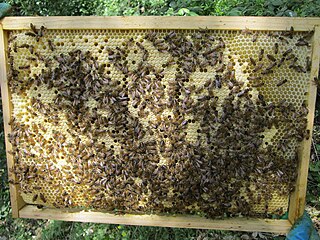
Eusociality, the highest level of organization of sociality, is defined by the following characteristics: cooperative brood care, overlapping generations within a colony of adults, and a division of labor into reproductive and non-reproductive groups. The division of labor creates specialized behavioral groups within an animal society which are sometimes referred to as 'castes'. Eusociality is distinguished from all other social systems because individuals of at least one caste usually lose the ability to perform at least one behavior characteristic of individuals in another caste. Eusocial colonies can be viewed as superorganisms.

The sense of smell, or olfaction, is the special sense through which smells are perceived. The sense of smell has many functions, including detecting desirable foods, hazards, and pheromones, and plays a role in taste.

Nasutitermes corniger is a species of arboreal termite that is endemic to the neotropics. It is very closely related to Nasutitermes ephratae. The species has been studied relatively intensively, particularly on Barro Colorado Island, Panama. These studies and others have shown that the termite interacts with many different organisms including a bat that roosts in its nest and various species of ants that cohabit with the termite.
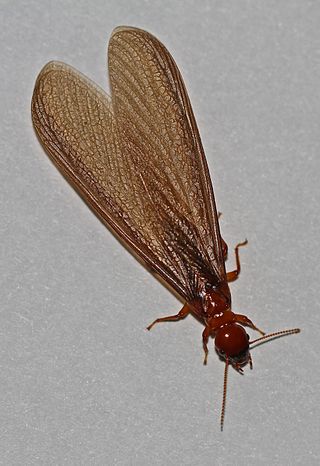
Zootermopsis angusticollis is a species of termite (Isoptera) in the family Archotermopsidae, a group known as the Pacific dampwood termites, or the rottenwood termites. As their name suggests, the dampwood termites can only survive by living off of wood that contains high amounts of moisture. They are found along the wet environments of the Pacific coast of North America. Most are found in the states of California, Oregon, Washington, Idaho, Western Nevada and in southern British Columbia. Termites are well known to be destroyers of wood, and although the dampwood termites can cause some damage, they are not as notoriously known to cause as much damage to buildings as the drywood termites. They occasionally have been carried to other parts of the country through wood shipments, but have not been able to become established in these areas due to undesirable environmental conditions.

Austroplatypus incompertus is a species of ambrosia beetle belonging to the true weevil family, native to Australia, with a verified distribution in New South Wales and Victoria. It forms colonies in the heartwood of Eucalyptus trees and is the first beetle to be recognized as a eusocial insect. Austroplatypus incompertus is considered eusocial because groups contain a single fertilized female that is protected and taken care of by a small number of unfertilized females that also do much of the work. The species likely passed on cultivated fungi to other weevils.

Eusociality evolved repeatedly in different orders of animals, notably termites and the Hymenoptera. This 'true sociality' in animals, in which sterile individuals work to further the reproductive success of others, is found in termites, ambrosia beetles, gall-dwelling aphids, thrips, marine sponge-dwelling shrimp, naked mole-rats, and many genera in the insect order Hymenoptera. The fact that eusociality has evolved so often in the Hymenoptera, but remains rare throughout the rest of the animal kingdom, has made its evolution a topic of debate among evolutionary biologists. Eusocial organisms at first appear to behave in stark contrast with simple interpretations of Darwinian evolution: passing on one's genes to the next generation, or fitness, is a central idea in evolutionary biology.
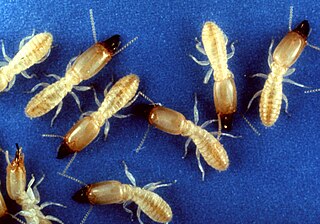
Reticulitermes is a termite genus in the family Rhinotermitidae. They are found in most temperate regions on Earth including much of Asia and the Middle East, Western Europe, and all of North America.

Incisitermes minor is a species of termite in the family Kalotermitidae known commonly as the western drywood termite. It is native to western North America, including the western United States and northern Mexico. It has been found in many other parts of the United States, all the way to the East Coast. It has been reported from Toronto. It has been introduced to Hawaii. It has been noted in China and it is not uncommon in Japan. This is an economically important pest of wooden structures, including houses. In California and Arizona alone its economic impact is estimated to be about $250 million per year.

Copidosoma floridanum is a species of wasp in the family Encyrtidae which is primarily a parasitoid of moths in the subfamily Plusiinae. It has the largest recorded brood of any parasitoidal insect, at 3,055 individuals. The life cycle begins when a female oviposits into the eggs of a suitable host species, laying one or two eggs per host. Each egg divides repeatedly and develops into a brood of multiple individuals, a phenomenon called polyembryony. The larvae grow inside their host, breaking free at the end of the host's own larval stage.
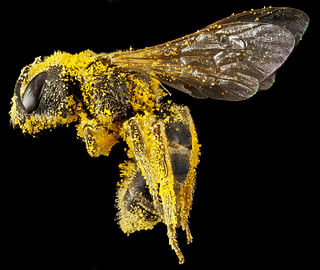
Halictus ligatus is a species of sweat bee from the family Halictidae, among the species that mine or burrow into the ground to create their nests. H. ligatus, like Lasioglossum zephyrus, is a primitively eusocial bee species, in which aggression is one of the most influential behaviors for establishing hierarchy within the colony, and H. ligatus exhibits both reproductive division of labor and overlapping generations.
Kladothrips is a genus of Australian gall thrips. It is notable for including some of the few organisms outside of Hymenoptera that exhibit eusociality.
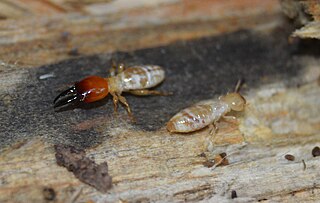
Zootermopsis is a genus of termites in the family Archotermopsidae. They are mostly found in western North America, ranging from Canada to Mexico, with the exception of Z. nevadensis, which has become established in Japan. They live in rotting wood, commonly inhabiting fallen or dead trees in North America's temperate rain forests, where they break down the wood's cellulose with the help of symbiotic protozoa and bacteria in their stomachs. The life and reproductive cycles of these termites are relatively normal compared to other members of its family. Species can be identified using the shape and position of the subsidiary tooth in all non-soldier castes, allowing a more certain identification than the previous method, which was based on the more ambiguous morphology of soldiers.

Insect olfaction refers to the function of chemical receptors that enable insects to detect and identify volatile compounds for foraging, predator avoidance, finding mating partners and locating oviposition habitats. Thus, it is the most important sensation for insects. Most important insect behaviors must be timed perfectly which is dependent on what they smell and when they smell it. For example, olfaction is essential for locating host plants and hunting prey in many species of insects, such as the moth Deilephila elpenor and the wasp Polybia sericea, respectively.
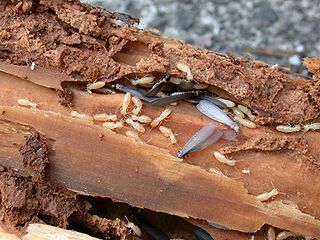
Reticulitermes speratus, the Japanese termite, is a species of subterranean termite found in Japan, North Korea, and South Korea. It eats decayed wood. It is adapted to withstand the cold temperatures of the temperate regions it inhabits.
Juvenile hormone acid O-methyltransferase (JHAMT) is a ~33 kDa enzyme that catalyzes the conversion of inactive precursors of Juvenile hormones (JHs) to active JHs in the final stages of JH biosynthesis in the corpora allata of insects. More specifically, the enzyme catalyzes the transfer of a methyl group from S-adenosyl-L-methionine (SAM) to the carboxylate group of JH precursors.


















